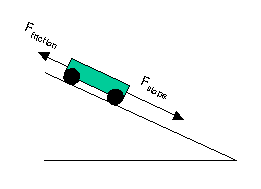
Solutions to SQA examination
1995 Higher Grade Physics
Paper I Solutions
Return to past paper index page.
1. E 11. E 21. D
2. C 12. C 22. D
3. B 13. D 23. A
4. D 14. D 24. E
5. A 15. B 25. D
6. B 16. C 26. E
7. B 17. D 27. E
8. D 18. D 28. A
9. E 19. E 29. A
10.A 20. C 30. C
31. u = 0m/s
s = 400
t = 17.5s
a = ?
s = ut + 1/2(at2)
400 = 0 + 0.5xa17.52
a = 400/153.25
a = 2.6m/s2
32. Fslope = mgsinq
Fslope = 2.0x9.8sin30o
Fslope = 9.8N
 Fresultant = Fslope - Ffriction
Fresultant = 9.8-4.0
Fresultant = 5.8N
33. P1 = 1.6x107Pa
V1 = 0.060m3
P2 = 2.5x105Pa
V2 = ?
P1V1 = P2V2
V2 = P1V1/P2
V2 = 3.84m3
34. E = QV
E = 5x12
E = 60J
35. The ratio Vc/Vs will decrease.
The current in the circuit increases as the frequency of the supply is
increased. This means the potential difference across the resistor(VR)
must have increased. Furthermore, as Vc decreases as VR increases,
the ratio Vc/Vs must decrease, if Vs is held constant.
36.a. The student requires to know :
i. the initial temperature of the lead;
ii. the mass of ice melted as a result of placing the lead
block in the ice; and
iii. the specific latent heat of fusion of water.
NB. Assume the lead block cools down to a temperature of 0oC.
b. Some of the melted ice is a result of heat from the surroundings
and not from the lead. Not allowing for this, by setting up a control
experiment, will increase the calculated amount of energy released by
the lead. This will in turn lead to a specific heat capacity greater than
the accepted value.
37.a. dsinq = nl
d = (1/300)mm = 0.00333mm = 3.333x10-6m
n = 2
q = 23o
l = ?
l = dsinq/n
l = 3.333x10-6sin23o/2
l = 651nm
b. Red
38. Mean t1/2 = Total/N
Mean t1/2 = (53.0+54.1+57.5+56.3+55.1)/5
Mean t1/2 = 276/5
Mean t1/2 = 55.2s
Random error = (max - min)/N
Random error = (57.5 - 53.0)/5
Random error = 4.5/5
Random error = 0.9s
t1/2 = (55.2+-0.9)s
Fresultant = Fslope - Ffriction
Fresultant = 9.8-4.0
Fresultant = 5.8N
33. P1 = 1.6x107Pa
V1 = 0.060m3
P2 = 2.5x105Pa
V2 = ?
P1V1 = P2V2
V2 = P1V1/P2
V2 = 3.84m3
34. E = QV
E = 5x12
E = 60J
35. The ratio Vc/Vs will decrease.
The current in the circuit increases as the frequency of the supply is
increased. This means the potential difference across the resistor(VR)
must have increased. Furthermore, as Vc decreases as VR increases,
the ratio Vc/Vs must decrease, if Vs is held constant.
36.a. The student requires to know :
i. the initial temperature of the lead;
ii. the mass of ice melted as a result of placing the lead
block in the ice; and
iii. the specific latent heat of fusion of water.
NB. Assume the lead block cools down to a temperature of 0oC.
b. Some of the melted ice is a result of heat from the surroundings
and not from the lead. Not allowing for this, by setting up a control
experiment, will increase the calculated amount of energy released by
the lead. This will in turn lead to a specific heat capacity greater than
the accepted value.
37.a. dsinq = nl
d = (1/300)mm = 0.00333mm = 3.333x10-6m
n = 2
q = 23o
l = ?
l = dsinq/n
l = 3.333x10-6sin23o/2
l = 651nm
b. Red
38. Mean t1/2 = Total/N
Mean t1/2 = (53.0+54.1+57.5+56.3+55.1)/5
Mean t1/2 = 276/5
Mean t1/2 = 55.2s
Random error = (max - min)/N
Random error = (57.5 - 53.0)/5
Random error = 4.5/5
Random error = 0.9s
t1/2 = (55.2+-0.9)s
END OF QUESTION PAPER
Return to past paper index page.


Fresultant = Fslope - Ffriction Fresultant = 9.8-4.0 Fresultant = 5.8N 33. P1 = 1.6x107Pa V1 = 0.060m3 P2 = 2.5x105Pa V2 = ? P1V1 = P2V2 V2 = P1V1/P2 V2 = 3.84m3 34. E = QV E = 5x12 E = 60J 35. The ratio Vc/Vs will decrease. The current in the circuit increases as the frequency of the supply is increased. This means the potential difference across the resistor(VR) must have increased. Furthermore, as Vc decreases as VR increases, the ratio Vc/Vs must decrease, if Vs is held constant. 36.a. The student requires to know : i. the initial temperature of the lead; ii. the mass of ice melted as a result of placing the lead block in the ice; and iii. the specific latent heat of fusion of water. NB. Assume the lead block cools down to a temperature of 0oC. b. Some of the melted ice is a result of heat from the surroundings and not from the lead. Not allowing for this, by setting up a control experiment, will increase the calculated amount of energy released by the lead. This will in turn lead to a specific heat capacity greater than the accepted value. 37.a. dsinq = nl d = (1/300)mm = 0.00333mm = 3.333x10-6m n = 2 q = 23o l = ? l = dsinq/n l = 3.333x10-6sin23o/2 l = 651nm b. Red 38. Mean t1/2 = Total/N Mean t1/2 = (53.0+54.1+57.5+56.3+55.1)/5 Mean t1/2 = 276/5 Mean t1/2 = 55.2s Random error = (max - min)/N Random error = (57.5 - 53.0)/5 Random error = 4.5/5 Random error = 0.9s t1/2 = (55.2+-0.9)s